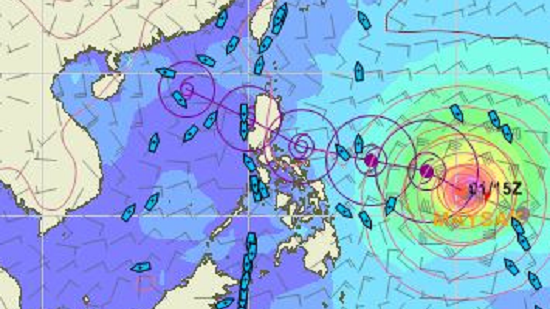Typhoons and Shipping - Know Your Options

By George Schlinkert, VP Routing Services at AWT
 Understanding of the development, structure, life cycle and motion of tropical cyclones is paramount to avoiding damage and loss of life and property at sea during these dangerous weather events. This article will explore some of the techniques that AWT Route Advisory Services undertake in helping captains and ship operators through the decision-making process to remain clear of them to save lives and property at sea and to achieve a cost-efficient journey.
Understanding of the development, structure, life cycle and motion of tropical cyclones is paramount to avoiding damage and loss of life and property at sea during these dangerous weather events. This article will explore some of the techniques that AWT Route Advisory Services undertake in helping captains and ship operators through the decision-making process to remain clear of them to save lives and property at sea and to achieve a cost-efficient journey.
By examining the trade route patterns for the Capesize and VLOC market during April 2015, AWT has identified several notable characteristics. In the graphic below, the seeming river of ships from Australia to China is clear, while the busy trade route from Brazil, around South Africa, then to China via Indonesian passages, is also notable.
Even at this early date in the year, Typhoon Maysak posed trouble along this route. Although typhoons can occur at any time of the year, there is a higher frequency from July through October. Typhoon Maysak was a super-typhoon, reaching winds near 130 knots at its center.
However, when looking at the warnings available regarding Typhoon Maysak from different agencies, one receives conflicting reports.
01 April, 2015 - 0000Z:
Japanese Met Agency: MAX WINDS 105 KNOTS NEAR CENTER
Typhoon Warning Center: MAX SUSTAINED WINDS 140 KT, GUSTS 170 KT
Chinese Met Agency: 62M/S (120 KNOTS)
While all three winds should be avoided, one might wonder why government agencies have such different analyses. It can be confusing to the mariner to get differing views on the same analysis. The reason has to do with how one defines a sustained wind. The below is the definition from the Joint Typhoon Warning Center (U.S. based Navy and Air Force task force) website.
“JTWC reports the maximum sustained surface winds in tropical disturbances and cyclones in terms of 1-minute mean wind speed, as required by the U.S. National Hurricane Operations Plan. Other nations, however, report maximum sustained surface winds averaged over a different time interval, which in many cases is 10-minutes.”
With this background, where does this leave us with regards to the weather routing services for these large ships?
AWT runs advanced wave models to take the strong winds in the tight wind radius of a cyclone into account, thereby better predicting the waves emanating from the center. AWT can therefore look at the highest quality data in order to calculate the progress of the ship in relation to the storm. Additionally, with analysts monitoring the situation 24/7, the situation is reviewed with each new storm forecast and compared to previous forecasts for that storm.
One avenue for storm avoidance is altering a ship’s speed. However, in this day of low fuel prices, the penalty of increasing speed is not as high as in previous years. Ship operators might wonder, “Is there any benefit to be gained by increasing speed?”
In calm seas, the following is calculated:
10 Knot Ship: 480 nm Two-day distances
12 Knot Ship: 576 nm Difference from 10-12 knots is 096 nm over two days
14 Knot Ship: 672 nm Difference from 10-14 knots is 192 nm over two days
For storms that span hundreds of miles, increase in speed is not always sufficient for safe passage. Add in the weather effects of gale to storm force northerly winds on the west-side of a storm, and increasing speed to run ahead of the storm loses its appeal in many cases as the increase in speed will be offset by the adverse effects of the winds and waves.
Taking a look at historical data available for this same region, one sees the effects of this from a similar storm in the summer of 2014. A hole develops in the positions of the fleet as some ships are clear or speed-up when able, or slow-down as needed. Accordingly, when the storm stagnates, the delivery and ETA of the ship delays or increases.
None of what has been discussed should be a surprise, as this scenario plays out in some form every year. However, with large turnover in shore-side ship operations, lessons learned from previous years may not be translated to future years. AWT can aide in bringing some sense to the mayhem by presenting historical data to all ship operators. AWT can help meet these challenges by providing assistance in determining safe and economical solutions for each voyage.
The products and services herein described in this press release are not endorsed by The Maritime Executive.
